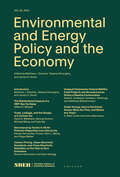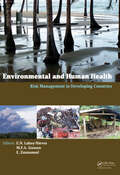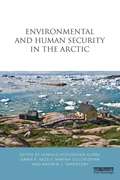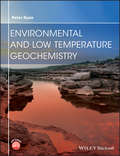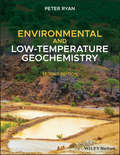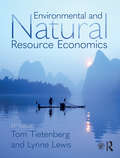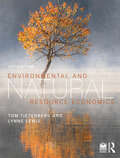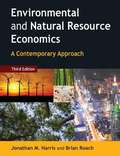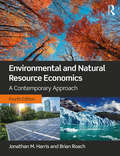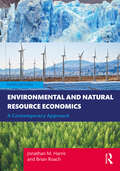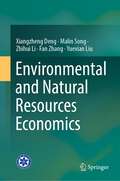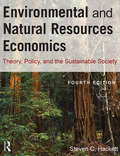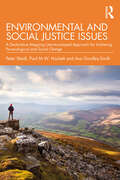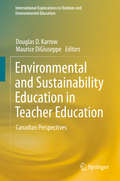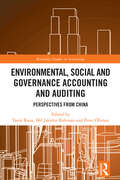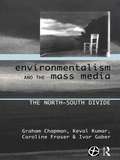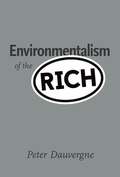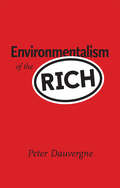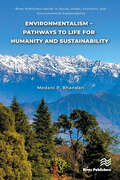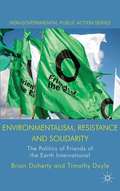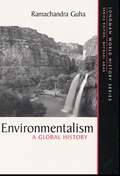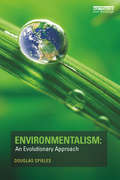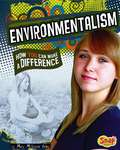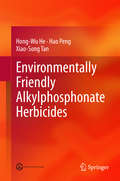- Table View
- List View
Environmental and Energy Policy and the Economy: Volume 4 (NBER-Environmental and Energy Policy and the Economy #4)
by The University of Chicago PressRigorous, careful, and nonpartisan research with a high policy impact on environmental and energy economics. Environmental and Energy Policy and the Economy focuses on the effective and efficient management of environmental and energy challenges. Research papers offer new evidence on the intended and unintended consequences, the market and nonmarket effects, and the incentive and distributional impacts of policy initiatives and market developments. This volume presents six new papers on environmental and energy economics and policy. Gilbert Metcalf examines the distributional impacts of substituting a vehicle miles-traveled tax for the existing federal excise tax in the United States. David Weisbach, Samuel Kortum, Michael Wang, and Yujia Yao consider solutions to the leakage problem of climate policy with differential tax policies on the supply and demand for fossil fuels and on domestic production and consumption. Danae Hernandez-Cortes, Kyle Meng, and Paige Weber quantify and decompose recent trends in air pollution disparities in the US electricity sector. Severin Borenstein and Ryan Kellogg provide a comparative analysis of different incentive-based mechanisms to reduce emissions in the electricity sector on a path to zero emissions. Sarah Anderson, Andrew Plantinga, and Matthew Wibbenmeyer document distributional differences in the allocation of US wildfire prevention projects. Finally, Mark Curtis and Ioana Marinescu provide new evidence on the quality and quantity of emerging “green” jobs in the United States.
Environmental and Human Health: Risk Management in Developing Countries
by Eddie N. Laboy-Nieves Mattheus F. A. Goosen Evens EmmanuelMany countries experience lack of harmony among economic development, environmental management and human health. As a consequence, public health, the integrity of ecosystems, and the efforts to reach environmental sustainability, have been adversely affected. The complexity, frequency and magnitude of those impacts is increasingly parallel to the t
Environmental and Human Security in the Arctic
by Gunhild Hoogensen Gjørv Dawn R. Bazely Marina Goloviznina Andrew J. TanentzapThis is the first comprehensive exploration of why human security is relevant to the Arctic and what achieving it can mean, covering the areas of health of the environment, identity of peoples, supply of traditional foods, community health, economic opportunities, and political stability. The traditional definition of security has already been actively employed in the Arctic region for decades, particularly in relation to natural resource sovereignty issues, but how and why should the human aspect be introduced? What can this region teach us about human security in the wider world? The book reviews the potential threats to security, putting them in an analytical framework and indicating a clear path for solutions.Contributions come from natural, social and humanities scientists, hailing from Canada, Russia, Finland and Norway. Environmental Change and Human Security in the Arctic is an essential resource for policy-makers, community groups, researchers and students working in the field of human security, particularly for those in the Arctic regions.
Environmental and Low Temperature Geochemistry
by Peter RyanEnvironmental and Low-Temperature Geochemistry presents conceptual and quantitative principles of geochemistry in order to foster understanding of natural processes at and near the earth’s surface, as well as anthropogenic impacts on the natural environment. It provides the reader with the essentials of concentration, speciation and reactivity of elements in soils, waters, sediments and air, drawing attention to both thermodynamic and kinetic controls. Specific features include: • An introductory chapter that reviews basic chemical principles applied to environmental and low-temperature geochemistry • Explanation and analysis of the importance of minerals in the environment • Principles of aqueous geochemistry • Organic compounds in the environment • The role of microbes in processes such as biomineralization, elemental speciation and reduction-oxidation reactions • Thorough coverage of the fundamentals of important geochemical cycles (C, N, P, S) • Atmospheric chemistry • Soil geochemistry • The roles of stable isotopes in environmental analysis • Radioactive and radiogenic isotopes as environmental tracers and environmental contaminants • Principles and examples of instrumental analysis in environmental geochemistry The text concludes with a case study of surface water and groundwater contamination that includes interactions and reactions of naturally-derived inorganic substances and introduced organic compounds (fuels and solvents), and illustrates the importance of interdisciplinary analysis in environmental geochemistry. Readership: Advanced undergraduate and graduate students studying environmental/low T geochemistry as part of an earth science, environmental science or related program. Additional resources for this book can be found at: www.wiley.com/go/ryan/geochemistry.
Environmental and Low-Temperature Geochemistry
by Peter RyanEnvironmental and Low-Temperature Geochemistry presents conceptual and quantitative principles of geochemistry in order to foster understanding of natural processes at and near the earth’s surface, as well as anthropogenic impacts and remediation strategies. It provides the reader with principles that allow prediction of concentration, speciation, mobility and reactivity of elements and compounds in soils, waters, sediments and air, drawing attention to both thermodynamic and kinetic controls. The scope includes atmosphere, terrestrial waters, marine waters, soils, sediments and rocks in the shallow crust; the temporal scale is present to Precambrian, and the spatial scale is nanometers to local, regional and global. This second edition of Environmental and Low-Temperature Geochemistry provides the most up-to-date status of the carbon cycle and global warming, including carbon sources, sinks, fluxes and consequences, as well as emerging evidence for (and effects of) ocean acidification. Understanding environmental problems like this requires knowledge based in fundamental principles of equilibrium, kinetics, basic laws of chemistry and physics, empirical evidence, examples from the geological record, and identification of system fluxes and reservoirs that allow us to conceptualize and understand. This edition aims to do that with clear explanations of fundamental principles of geochemistry as well as information and approaches that provide the student or researcher with knowledge to address pressing questions in environmental and geological sciences. New content in this edition includes: Focus Boxes – one every two or three pages – providing case study examples (e.g. methyl isocyanate in Bhopal, origins and health effects of asbestiform minerals), concise explanations of fundamental concepts (e.g. balancing chemical equations, isotopic fractionation, using the Keq to predict reactivity), and useful information (e.g. units of concentration, titrating to determine alkalinity, measuring redox potential of natural waters); Sections on emerging contaminants for which knowledge is rapidly increasing (e.g. perfluorinated compounds, pharmaceuticals and other domestic and industrial chemicals); Greater attention to interrelationships of inorganic, organic and biotic phases and processes; Descriptions, theoretical frameworks and examples of emerging methodologies in geochemistry research, e.g. clumped C-O isotopes to assess seawater temperature over geological time, metal stable isotopes to assess source and transport processes, X-ray absorption spectroscopy to study oxidation state and valence configuration of atoms and molecules; Additional end-of-chapter problems, including more quantitatively based questions. Two detailed case studies that examine fate and transport of organic contaminants (VOCs, PFCs), with data and interpretations presented separately. These examples consider the chemical and mineralogical composition of rocks, soils and waters in the affected system; microbial influence on the decomposition of organic compounds; the effect of reduction-oxidation on transport of Fe, As and Mn; stable isotopes and synthetic compounds as tracers of flow; geological factors that influence flow; and implications for remediation. The interdisciplinary approach and range of topics – including environmental contamination of air, water and soil as well as the processes that affect both natural and anthropogenic systems – make it well-suited for environmental geochemistry courses at universities as well as liberal arts colleges.
Environmental and Natural Resource Economics
by Lynne Lewis Thomas H. TietenbergEnvironmental and Natural Resource Economics is the best-selling text for natural resource economics and environmental economics courses, offering a policy-oriented approach and introducing economic theory and empirical work from the field. Students will leave the course with a global perspective of both environmental and natural resource economics and how they interact. Complemented by a number of case studies showing how underlying economic principles provided the foundation for specific environmental and resource policies, this key text highlights what can be learned from the actual experience. This new, 11th edition includes updated data, a number of new studies and brings a more international focus to the subject. Key features include: Extensive coverage of the major issues including climate change, air and water pollution, sustainable development, and environmental justice. Dedicated chapters on a full range of resources including water, land, forests, fisheries, and recyclables. Introductions to the theory and method of environmental economics including externalities, benefit-cost analysis, valuation methods, and ecosystem goods and services. Boxed ‘Examples’ and ‘Debates’ throughout the text which highlight global examples and major talking points. The text is fully supported with end-of-chapter summaries, discussion questions, and self-test exercises in the book and multiple-choice questions, simulations, references, slides, and an instructor’s manual on the Companion Website.
Environmental and Natural Resource Economics
by Tom Tietenberg Lynne LewisEnvironmental and Natural Resource Economics is one of the most widely used textbooks for environmental economics and natural resource economics courses, offering a policy-oriented approach and introducing economic theory and empirical work from the field. Students will develop a global perspective of both environmental and natural resource economics and how they interact. This 12th edition provides updated data, new studies, and more international examples. There is a considerable amount of new material, with a deeper focus on climate change and coverage of COVID-19, social justice, and the circular economy. Key features include: Extensive coverage of major contemporary issues including climate change, water and air pollution, resource allocation, biodiversity protection, sustainable development, and environmental justice. Four chapters specifically devoted to climate economics, including chapters on energy, climate mitigation, carbon pricing, and adaptation to climate change. Introductions to the theory and method of environmental economics, including externalities, benefit-cost analysis, valuation methods, and ecosystem goods and services and updates to the social cost of carbon. New examples and debates throughout the text, highlighting global cases and major talking points. Environmental and Natural Resource Economics supports students with end-of-chapter summaries, discussion questions, exercises, and further reading in the book, and the companion website offers additional learning and teaching resources.
Environmental and Natural Resource Economics: A Contemporary Approach
by Jonathan M. Harris Brian RoachHarris and Roach present a compact and accessible presentation of the core environmental and resource topics and more, with analytical rigor as well as engaging examples and policy discussions. They take a broad approach to theoretical analysis, using both standard economic and ecological analyses, and developing these both from theoretical and practical points of view. It assumes a background in basic economics, but offers brief review sections on important micro and macroeconomic concepts, as well as appendices with more advanced and technical material. Extensive instructor and student support materials, including PowerPoint slides, data updates, and student exercises are provided.
Environmental and Natural Resource Economics: A Contemporary Approach
by Jonathan M. Harris Brian RoachEnvironmental issues are of fundamental importance, and a broad approach to understanding the relationship of the human economy and the natural world is essential. In a rapidly changing policy and scientific context, this new edition of Environmental and Natural Resource Economics reflects an updated perspective on modern environmental topics. Now in its fourth edition, this book includes new material on climate change, the cost-competitiveness of renewable energy, global environmental trends, and sustainable economies. The text provides a balanced treatment of both standard environmental economics and ecological economics, based on the belief that these two approaches are complementary. Several chapters focus on the core concepts of environmental economics, including the theory of externalities, the management of public goods, the allocation of resources across time, environmental valuation, and cost-benefit analysis. Material on ecological economics includes such topics as macroeconomic scale, entropy, and "green" national accounting. Topical chapters focus on: energy; climate change; water resources; international trade; forests; fisheries; and agriculture, with an emphasis on designing effective policies to promote sustainability and a "green" economy. Harris and Roach’s premise is that a pluralistic approach is essential to understand the complex nexus between the economy and the environment. This perspective, combined with its emphasis on real-world policies, is particularly appealing to both instructors and students. This is the ideal text for classes on environmental, natural resource, and ecological economics.
Environmental and Natural Resource Economics: A Contemporary Approach
by Jonathan M. Harris Brian RoachEnvironmental issues are of fundamental importance, and a broad approach to understanding the relationship between the human economy and the natural world is essential. In a rapidly changing policy and scientific context, this new edition of Environmental and Natural Resource Economics reflects an updated perspective on modern environmental topics. Now in its fifth edition, this textbook includes enhanced and updated material on energy, climate change, greening the economy, population, agriculture, forests and water—reflecting the greater urgency required to solve the big environmental problems in these areas. It introduces students to both standard environmental economics and the broader perspective of ecological economics, balancing analytical techniques of environmental economics topics with a global perspective on current ecological issues such as population growth, global climate change and "green" national income accounting. Harris and Roach’s premise is that a pluralistic approach is essential to understand the complex nexus between the economy and the environment. This perspective, combined with its emphasis on real-world policies, is particularly appealing to both instructors and students. This is the ideal text for undergraduate classes on environmental, natural resource and ecological economics, and postgraduate courses on environmental and economic policy. The companion website features PowerPoint materials and extended, chapter-specific discussion points.
Environmental and Natural Resource Economics: A Contemporary Approach
by Jonathan M. Harris Brian RoachEnvironmental issues are of fundamental importance, and a broad approach to understanding the relationship between the human economy and the natural world is essential. In a rapidly changing policy and scientific context, this new edition of Environmental and Natural Resource Economics reflects an updated perspective on modern environmental topics.Now in its fifth edition, this textbook includes enhanced and updated material on energy, climate change, greening the economy, population, agriculture, forests and water—reflecting the greater urgency required to solve the big environmental problems in these areas. It introduces students to both standard environmental economics and the broader perspective of ecological economics, balancing analytical techniques of environmental economics topics with a global perspective on current ecological issues such as population growth, global climate change and "green" national income accounting.Harris and Roach’s premise is that a pluralistic approach is essential to understand the complex nexus between the economy and the environment. This perspective, combined with its emphasis on real-world policies, is particularly appealing to both instructors and students. This is the ideal text for undergraduate classes on environmental, natural resource and ecological economics, and postgraduate courses on environmental and economic policy.To access Student and Instructor resources, please visit: sites.tufts.edu/gdae/environmental-and-natural-resource-economics/
Environmental and Natural Resources Economics
by Fan Zhang Xiangzheng Deng Zhihui Li Malin Song Yuexian LiuThis book aims to integrate multiple disciplinary such as management, economics, and geography from the perspective of resource science and also to strengthen research on resource management to promote sustainability in natural resources. It established clear definition of natural resources and in-depth exploration of main fields such as water resources, land resources, and agricultural resources. Classic methods of economics are applied to solve the problems of resource consumption, environmental pollution, and climate change in modern society. On the basis of classical economics, the disciplinary system of environmental and natural resources is further developed. It is a helpful reference for readers to further study natural resources and environmental economics.
Environmental and Natural Resources Economics: Theory, Policy, and the Sustainable Society
by Steven C. HackettExtensively revised and updated, this popular text presents an accessible yet rigorous treatment of environmental and natural resources economics, including climate change and the economics of sustainability. Completely revised and updated, the fourth edition now includes new figures and tables, definitions to assist the reader, and updated policy information. New advances in the science, economics and policy approaches to climate change have been integrated into essentially all-new chapters on incentive regulation and global climate change. This innovative textbook integrates economics with science and public policy in a balanced and accessible way that will be appreciated by students from disciplines ranging from economics and natural resources management to environmental studies and energy policy.
Environmental and Social Justice Issues: A Declarative Mapping Literature-based Approach for Achieving Pro-ecological and Social Change
by Paul M.W. Hackett Ava Gordley-Smith Peter SteidlThis book uses a declarative mapping methodology to examine a range of issues relating to environmental and social justice issues, including climate change, homelessness, refugees, food insecurity, and racial and gender inequality. The book explores how we can bring about change in order to have a meaningful impact on these problems, using a literature-based approach to identify and analyse this through the Declarative Mapping Method, showing how this methodology can be used in the context of these issues. The authors build a body of knowledge based upon published research, to offer a template that may be used to bring about meaningful and appropriate changes in human behaviour in a variety of social/ecological justice contexts. In a world where most of the global challenges we face are a result of human behaviour, the book applies psychological principles to gain a deeper understanding of our responses to world issues. Case studies are included to show how specific strategies can be used to address problems, and a holistic perspective offers strategies and insights into addressing these challenges. This is an ideal text for researchers and students interested in environmental and social issues, especially those looking to find ways to address them through research methodologies.
Environmental and Sustainability Education in Teacher Education: Canadian Perspectives (International Explorations in Outdoor and Environmental Education)
by Douglas D. Karrow Maurice DiGiuseppeThis book was inspired by the inaugural National Roundtable on Environmental and Sustainability Education in Canadian Faculties of Education (Roundtable 2016), which took place June 14-16, 2016, at Trent University in Peterborough, Ontario. Roundtable 2016 brought together over seventy participants from across Canada, including educators, researchers, policy-makers, consultants, and community organizations. Over the course of three days, participants took part in keynote addresses, research colloquia, networking socials, and collaborative inquiry activities focused on Environmental Sustainability Education in Teacher Education (ESE-TE). Roundtable 2016 resulted in the publication of a National Action Plan containing action-oriented recommendations for enhancing ESE-TE, and a position statement titled “The Otonabee Declaration,” where delegates articulated their views regarding environmental degradation, the critical need for enhancing ESE-TE, and, the role educators, children, youth, educational institutions, policy makers, and Indigenous communities play in enhancing ESE-TE in Canada. This volume concludes with a discussion placing current Canadian ESE-TE theory and practice within an international context.
Environmental, Social and Governance Accounting and Auditing: Perspectives from China (Routledge Studies in Accounting)
by Tarek Rana Peter Öhman Md Jahidur RahmanIn a rapidly evolving world where Environmental, Social, and Governance (ESG) considerations are at the forefront of business and investment decisions, understanding the intricate interplay between ESG factors and corporate performance is paramount. This book demystifies ESG by providing empirical insights from the unique perspective of China, shedding light on the impact of ESG on financial performance and corporate governance. It investigates the impact of environmental expertise, social variability, and board governance model on firm performance.The book sets the stage by introducing the reader to the significance of ESG in today's corporate world, examining empirical evidence gathered from a decade of data analysis on Chinese-listed companies. It explores how ESG practices influence corporate financial performance and what role audit quality plays in this equation. Drawing from a wealth of data, it provides practical insights into the effects of ESG disclosure, ownership structures, corporate governance, and more on the performance of businesses. It offers a clear understanding of the empirical realities in China while addressing a global audience interested in harnessing ESG for sustainable corporate success. It provides valuable lessons and comparisons that can benefit readers beyond China's borders.The book bridges the gap between research and practice, translating complex research findings into actionable recommendations, enhancing its appeal to both academic and professional audiences. It is a must-read for scholars, students and researchers seeking actionable insights into the world of ESG. Further, it discusses ESG practice and policy implications, offering recommendations for stakeholders including policymakers, investors, managers, and auditors.
Environmentalism and the Mass Media: The North/South Divide (Global Environmental Change Ser.)
by Caroline Fraser Ivor Gaber Graham Chapman Keval KumarThe mass media in different countries reflects dominant concerns of contemporary societies. Ideas of `environmentalism' are often broad and imprecise, holding neither meaning nor currency. Environmentalism and Mass Media sheds new light on the diverse ideas of `environmentalism', the way environmental ideas circulate, and public reaction to environmental concerns conveyed by the media. Drawing on unique interviews with journalists, media pictures, and public opinion surveys in both UK and India, the authors outline the differing cultural, religious and political contexts against which `world views' form present a fascinating picture between North and South. Mass media and communication technology is in danger of locking Northern countries into a ghetto of environmental self-deception, thereby perpetuating poverty in the South. The South's goal remains the attainment of development; the North sees `environmental' problems occuring `elsewhere' - in Eastern Europe and developing countries. Whether or not `environmentalism' becomes a universal cause depends on how and to what extent such sharply contrasting world views can converge.
Environmentalism of the Rich
by Peter DauvergneOver the last fifty years, environmentalism has emerged as a clear counterforce to the environmental destruction caused by industrialization, colonialism, and globalization. Activists and policymakers have fought hard to make the earth a better place to live. But has the environmental movement actually brought about meaningful progress toward global sustainability? Signs of global "unsustainability" are everywhere, from decreasing biodiversity to scarcity of fresh water to steadily rising greenhouse gas emissions. Meanwhile, as Peter Dauvergne points out in this provocative book, the environmental movement is increasingly dominated by the environmentalism of the rich -- diverted into eco-business, eco-consumption, wilderness preservation, energy efficiency, and recycling. While it's good that, for example, Barbie dolls' packaging no longer depletes Indonesian rainforest, and that Toyota Highlanders are available as hybrids, none of this gets at the source of the current sustainability crisis. More eco-products can just mean more corporate profits, consumption, and waste.Dauvergne examines extraction booms that leave developing countries poor and environmentally devastated -- with the ruination of the South Pacific island of Nauru a case in point; the struggles against consumption inequities of courageous activists like Bruno Manser, who worked with indigenous people to try to save the rainforests of Borneo; and the manufacturing of vast markets for nondurable goods--for example, convincing parents in China that disposable diapers made for healthier and smarter babies.Dauvergne reveals why a global political economy of ever more -- more growth, more sales, more consumption -- is swamping environmental gains. Environmentalism of the rich does little to bring about the sweeping institutional change necessary to make progress toward global sustainability.
Environmentalism of the Rich
by Peter DauvergneWhat it means for global sustainability when environmentalism is dominated by the concerns of the affluent—eco-business, eco-consumption, wilderness preservation. Over the last fifty years, environmentalism has emerged as a clear counterforce to the environmental destruction caused by industrialization, colonialism, and globalization. Activists and policymakers have fought hard to make the earth a better place to live. But has the environmental movement actually brought about meaningful progress toward global sustainability? Signs of global “unsustainability” are everywhere, from decreasing biodiversity to scarcity of fresh water to steadily rising greenhouse gas emissions. Meanwhile, as Peter Dauvergne points out in this provocative book, the environmental movement is increasingly dominated by the environmentalism of the rich—diverted into eco-business, eco-consumption, wilderness preservation, energy efficiency, and recycling. While it's good that, for example, Barbie dolls' packaging no longer depletes Indonesian rainforest, and that Toyota Highlanders are available as hybrids, none of this gets at the source of the current sustainability crisis. More eco-products can just mean more corporate profits, consumption, and waste. Dauvergne examines extraction booms that leave developing countries poor and environmentally devastated—with the ruination of the South Pacific island of Nauru a case in point; the struggles against consumption inequities of courageous activists like Bruno Manser, who worked with indigenous people to try to save the rainforests of Borneo; and the manufacturing of vast markets for nondurable goods—for example, convincing parents in China that disposable diapers made for healthier and smarter babies. Dauvergne reveals why a global political economy of ever more—more growth, more sales, more consumption—is swamping environmental gains. Environmentalism of the rich does little to bring about the sweeping institutional change necessary to make progress toward global sustainability.
Environmentalism – Pathways to Life for Humanity and Sustainability (River Publishers Series in Social, Urban, Economic and Environmental Sustainability)
by Medani P. BhandariThis is a comprehensive exploration of the diverse challenges and solutions related to environmentalism and sustainability. It bridges the gaps between theory and practice, offering practical insights for academics, policymakers, and change agents. It also inspires informed action and collaborative efforts for creating a sustainable future, offering new knowledge to those who care deeply about the planet and humanity’s future.The book begins with the evolution of environmentalism; tracing how ecological awareness has shaped global movements and policies. It also delves into theories of sustainability, demonstrating their relevance in addressing contemporary environmental crises. Central to the discussion is the concept of resource inequality, revealing how disproportionate resource access hinders global development and sustainability. It also explores the sustainable development goals (SDGs), presenting them as vital frameworks for policy and action, alongside climate change mitigation strategies like renewable energy, carbon sequestration, and biodiversity conservation. In the context of social equity and environmental justice, it addresses global disparities, underscoring the need for inclusive and fair solutions.Technological innovation is presented as a key driver for transforming economies into more sustainable models, including the circular economy and green finance. Furthermore, the book highlights behavioral change, mental health, and well-being as integral to advancing environmentalism.Corporate responsibility and global cooperation are examined for their roles in driving collective action, and the book emphasizes the importance of these stakeholders in addressing the environmental crisis. It also introduces the epistemology of the development economy, providing a fresh lens on sustainability that can inform both academic inquiry and practical applications.
Environmentalism, Resistance and Solidarity
by Brian Doherty Timothy DoyleIn the first detailed study of how a major environmental NGO works transnationally, Brian Doherty and Timothy Doyle examine the relationships between the 74 national organizations of Friends of the Earth International. Drawing from a rich mix of survey data, interviews, archival sources and access to internal meetings, they show how FoEI has developed a distinctive international environmentalism, which allows for the differences in context between regions and across the North-South divide. Following the expansion of FoEI into the global South, the challenges it then faced over questions of ideology, organization and campaign strategy are examined over a twenty year period. The book demonstrates the development of an FoEI tradition of solidarity which accounts for its ability to overcome internal crises and pursue joint campaigns despite conflicting understandings of politics between its national organizations.
Environmentalism: A Global History
by Ramachandra GuhaA new entry in the Longman World History Series, Environmentalism: A Global History is perfect for professors who want to assign short topical paperbacks which explore global issues and movements in their world history classes. This volume will fit into the second half of World History courses which typically cover the period from 1500 to the present century. Environmentalism: A Global History is the first genuinely global history of environmentalism. Written by one of the foremost thinkers on ecological issues relating to South Africa, Guha has become one of the more provocative and perceptive commentators on environmentalism in its cross-cultural and global dimensions. Students will find this new text to be a lively and engaging study of ideas and debates that are central to our lives in the twentieth-first century.
Environmentalism: An Evolutionary Approach
by Douglas SpielesThe premise of this book is that our environmental dilemmas are products of biological and sociocultural evolution, and that through an understanding of evolution we can reframe debates of thought and action. The purpose is to explain the wide variety of environmental worldviews, their origins, commonalities, points of contention, and their implications for the modern environmental movement. In three parts covering the origins, evolution and future of environmentalism, it offers instructors and students a framework on which to map theory, case studies and classical literature. It is shown that environmentalism can be described in terms of six human values—utility, stability, equity, beauty, sanctity, and morality—and that these are deeply rooted in our biological and cultural origins. In building this case the book draws upon ecology, philosophy, psychology, history, biology, economics, spirituality, and aesthetics, but rather than consider these all independently it integrates them to craft a mosaic narrative of our species and its home. From our evolutionary origins a story emerges; it is the story of humankind, how we have come to threaten our own existence, and why we seem to have such difficulty in acting together to ensure our common future. Understanding our environmental problems in evolutionary terms gives us a way forward. It suggests an environmentalism in which material views of human life include spirituality, in which our anthropocentric behaviors incorporate ecological function, and in which environmental problems are addressed by the intentional relation of humans to the nonhuman world and to one another. Aimed at students taking courses in environmental studies, the book brings clarity to a complex and, at times, confusing array of ideas and concepts of environmentalism.
Environmentalism: How You Can Make a Difference
by Mary Mcintyre ColeyDescribes what environmental activism is and serves as a guide explaining how youth can make change in their world.
Environmentally Friendly Alkylphosphonate Herbicides
by Hong-Wu He Hao Peng Xiao-Song TanThis book presents essential research on a class of environmentally friendly alkylphosphonate herbicides. This class of herbicides acted as a competitive inhibitor of the pyruvate dehydrogenase complex (PDHc) to control weeds. The bioreasoning and systematic approach, from basic research to field tests of candidate compounds, are introduced. The basic research covers the molecular design, chemical synthesis, biological activities evaluation, structure-activity relationship analysis and structural optimization. Subsequently, the book reviews the biochemistry of PDHc inhibitors, the selectivity between mammals and plants, and the mechanism of herbicidal activity of novel alkylphosphonates as selective PDHc inhibitors. Field trials for selected alkylphosphonate candidates as herbicides are also included. This book provides a sound basis for the rational design and development of novel herbicides as effective PDHc inhibitors with good enzyme-selective inhibition of plant PDHc between mammals and plants. These studies take full advantages of the low toxicity and low residual impact of selective PHDc inhibitors to design an effective and environmentally friendly herbicide. This book is based on twenty years of research on alkylphosphonates and phosphorus-containing PDHc inhibitors, and demonstrates how to develop these PDHc inhibitors as an effective and "green" herbicide candidate. Hong-Wu He, PhD, is a Professor at the Key Laboratory of Pesticide & Chemical Biology, Ministry of Education of China, and Director of the Institute of Pesticide Chemistry, College of Chemistry, Central China Normal University, China. Hao Peng, PhD, and Xiao-Song Tan are both Associate Professors at the Key Laboratory of Pesticide & Chemical Biology, Ministry of Education of China, College of Chemistry, Central China Normal University, China.
